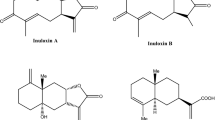Abstract
The potential egg production and egg viability of the potato tuber moth, Phthorimaea operculella (Zell.) was significantly towered when moths of either sex were exposed in 250 ml glass jars to vapours of orange peel oil emanating from 160 μ oil. Oviposition and egg hatching was totally inhibited when female moths of both sexes were exposed to 220 μl of the oil.
Résumé
Le potentiel reproductif (exprimè par le nombre d’oeufs et leur viabilite) des mites de pomme de terre Phthorimaea operculella (Zell.) etait significativement diminuè quand les mites des deux sex étaient exposes au vapeur de 160 μl huile d’ecorce d’orange. Oviposition et éclosion d’oeufs etaient prohibes quand les males et femmelles des mites etaient exposés au vapeur de 220 μl d’huile.
Similar content being viewed by others
References
Braverman J. B. S. (1949) Citrus Products: Chemical Composition and Chemical Technology. Interscience Publishers, New York, N.Y.
Dongre T. K. and Rahalkar G. W. (1982) Effect of Blumea eriantha (Composita) oil on reproduction in Earias vitella. Experientia (Basel) 38, 98–99.
Don-Pedro K. N. (1985) Toxicity of some citrus peels to Dermestes maculatus Deg. and Callosobruchus maculatus (F.). J. Stored Prod. Res. 81, 31–34.
Duncan D. B. (1955) Multiple range and multiple F test. Biometrics, 11, 1–42.
Günther E. (1948) The Essential Oils. D. Van Nostrand Co. Inc., New York, N.Y.
Jacobson M. (1958) Insecticides from plants—review of literature. L941–L953 USDA Agric. Handbk. 154, 299.
Lichtenstein E. P. (1966) Insecticides occurring naturally in crops. Adv. Chem. Ser. 53, 34–38.
Meisner J. and Ascher K. R. S. (1972) Feeding stimulants for the larva of the Egyptian cotton leafworm, Spodoptera littoralis Boisd. II. Assaying the larval feeding response to extracts of fruits and their peels with the Styropor method. Z. Angew. Ent. 71, 337–349.
Orphanidis P. S. and Kalmoukos (1970) Negative chemotropism of Dacus oleae (Gmel.) adults against essential oils. Ann. Inst. Phytopath. Benaki N.S. 9, 288–294.
Pathak P. H. and Krishna S. S. (1985) Neem seed oil, a capable ingredient to check rice moth reproduction (Lepid, Galleriidae). Z. Angew. Ent. 100, 33–35.
Su H. C. F., Speirs R. D. and Mahany P. G. (1972) Toxicity of citrus oil to several stored product insects—laboratory evaluations. J. econ. Ent. 65, 1438–1441.
Author information
Authors and Affiliations
Rights and permissions
About this article
Cite this article
Sharaby, A. Effect of Orange, Citrus sinensis (L.) Peel Oil on Reproduction in Phthorimaea operculella (Zell.). Int J Trop Insect Sci 9, 201–203 (1988). https://doi.org/10.1017/S174275840000597X
Received:
Revised:
Published:
Issue Date:
DOI: https://doi.org/10.1017/S174275840000597X




